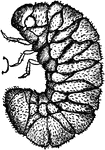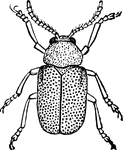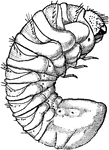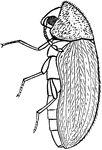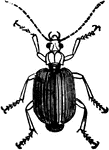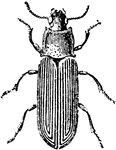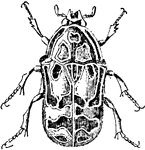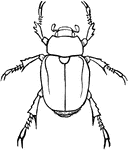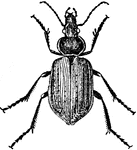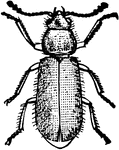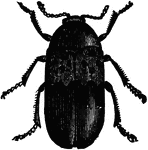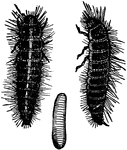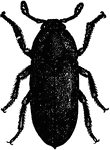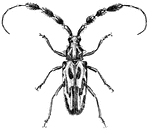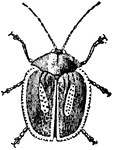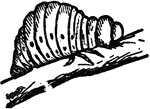
Colorado Beetle Larva
"The Colorado Beetle is a beetle first described by Thomas Say, in 1824, from specimens found by him…
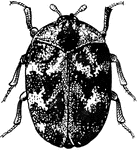
Adult Common Carpet Beetle
An adult common carpet beetle, a small grayish or black beetle belonging to the order Coleoptera.

Common Carpet Beetle Larva
Larva of the common carpet beetle, a small grayish or black beetle belonging to the order Coleoptera.

Common Carpet Beetle Larva
Larva of the common carpet beetle, a small grayish or black beetle belonging to the order Coleoptera.

Common Carpet Beetle Pupa
Pupa of the common carpet beetle, a small grayish or black beetle belonging to the order Coleoptera.

Corn Beetle
"Corn Beetle: a, larva, natural size; b, larva, magnified; c, perfect insect, natural dize; d, perfect…

Deathwatch Beetles
"Other species, which also bore into timber in their larva state, are well known by the name of Death-watch…

Diamond Beetle
"Even among the small species several of great beauty are to be met with, and few insects can boast…
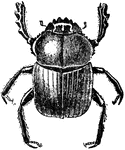
Dung Beetle
"A black insect, with brilliant metallic blue or purple reflections on the under side, and well known…

Dung Beetle
"A black insect, with brilliant metallic blue or purple reflections on the under side, and well known…
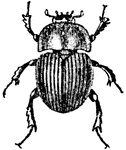
Dung Beetle
"A black insect, with brilliant metallic blue or purple reflections on the under side, and well known…
!["They introduce themselves under the skin of the carcasses of animals, and devour their flesh to the bone. [This] species climbs trees and attacks caterpillars."](https://etc.usf.edu/clipart/53400/53403/53403_silpha_quadr_mth.gif)
Dung Beetle (Silpha Quadrapunctata)
"They introduce themselves under the skin of the carcasses of animals, and devour their flesh to the…

Four-Spotted Beetle
"Smallish insects, generally of a black color, with the elytra rather shorter than the body, which is…
!["One of the largest European beetles, the Brown Hydrophile, <em>Hydrous piceus</em>, which is common in ponds in some localities, belongs to [the philhydrida]." — Goodrich, 1859](https://etc.usf.edu/clipart/14600/14660/brownhydro_14660_mth.gif)
Giant Silver Beetle
"One of the largest European beetles, the Brown Hydrophile, Hydrous piceus, which is common…

Golden Ground Beetle (Carabus Auratus)
"Abounds in trees and gardens. When it is touched it disgorges a black and acrid saliva, and ejects…

Golden Tortoise Beetle
Beetles that feed on sweet potato, morning glory, and other convolvulaceous plants.

Goliath Beetle
The African goliath-beetles and the american elephant-beetles are the largest of all insects.

Great Diving Beetle
Dytiscus Harminieri, a genus of predatory, diving beetles that usually live in wetlands and ponds.

Great Diving Beetle
Dytiscus Harminieri, a genus of predatory, diving beetles that usually live in wetlands and ponds.
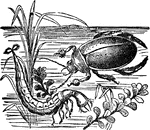
Great Diving Beetle
"A, Dytiscus Marginalis, or great Water-beetle; B, larva." — Chambers' Encyclopedia, 1875

Great Diving Beetle Adult and Larvae
"The Dyticus marginalis, a European species very common in ponds, attains a length of more…

Great Diving Beetle Female
"The Dyticus marginalis, a European species very common in ponds, attains a length of more…
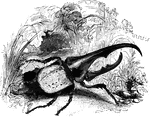
Hercules Beetle
"The hercules beetle is a native of Brazil, sometimes attaining a length of five inches." — Goodrich,…
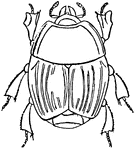
Hister Beetle
Hister Arcuatus, or clown beetle. Small, oval, shining, very hard, black bronzed or greenish beetles,…

Hister Beetle
Hister Bimaculatus, or clown beetle. Small, oval, shining, very hard, black bronzed or greenish beetles,…

Lard Beetles
"Received its specific name on account of the fondness exhibited by its curious larva for bacon." —…

Leaf Beetle
"The Popular-tree Golden bug, chrysomela populi, of a blueish-green, has a strong odor, and…
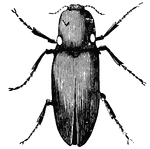
Lightning Spring Beetles
Beetles form a large group of insects that number over 300,000 species. They all have hard wings which…
